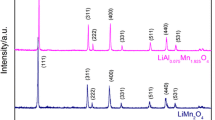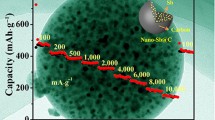Abstract
For the urgent demand of higher capacity of lithium-ion battery anode, tin pyrophosphate has attracted more and more attention because of its high theoretical capacity, cheapness, and no toxicity. However, production of stable mesoporous sphere structure and improvement of electrochemical performance remain a challenge. Here, SnP2O7 spherical particles were successfully prepared through spray drying method with SnCl4·5H2O and C2H8O7P2. Crystallization and microstructure were investigated by TG-DSC, XRD, SEM, and TEM. With the obtained mesoporous SnP2O7 particles after carbon coating, it demonstrates a high initial capacity reaching up to 1218 mAh g−1 and a significantly stable cycling performance with 620 mAh g−1 after 80 deep electrochemical cycles.




Similar content being viewed by others
References
Armand M, Tarascon JM (2008) Building better batteries. Nature 451 (7179):652–657
Wu H, Chan G, Choi JW, Ryu I, Yao Y, McDowell MT, Lee SW, Jackson A, Yang Y, LB H, Cui Y (2012) Stable cycling of double-walled silicon nanotube battery anodes through solid-electrolyte interphase control. Nat Nanotechnol 7(5):309–314
Tin-Graphene Anode Boosts Li-Ion Battery Capacity (2011). Chem Eng Prog 107 (9):14–14
Derrien G, Hassoun J, Panero S, Scrosati B (2007) Nanostructured Sn-C composite as an advanced anode material in high-performance lithium-ion batteries. Adv Mater 19 (17):2336 − +
Wang XJ, Zhai GH, Wang H (2015) Synthesis and electrochemical investigation of tin dioxide-based elastic hollow microspheres for lithium storage. Ionics 21(6):1533–1538
Wang LB, Kitamura S, Obata K, Tanase S, Sakai T (2005) Multilayered Sn-Zn-Cu alloy thin-film as negative electrodes for advanced lithium-ion batteries. J Power Sources 141(2):286–292
Atar N, Eren T, Yola ML, Gerengi H, Wang SB (2015) Fe@Ag nanoparticles decorated reduced graphene oxide as ultrahigh capacity anode material for lithium-ion battery. Ionics 21(12):3185–3192
Palanichamy K (2011) On the modified inverse spinel-LiCo(PO4)(x)(VO4)(1-x) as cathode for rechargeable lithium batteries. Ionics 17 (5):391–397
Gejke C, Borjesson L, Edstrom K (2003) Cycling performance and temperature stability of a tin-borate glass anode. Electrochem Commun 5(1):27–31
Ho WH, Yen SK (2005) Electrochemical synthesis of SnHPO4/H3PO3 on Pt and forming SnP2O7. Electrochem Solid St 8(10):C134–C137
Lee JG, Son D, Kim C, Park B (2007) Electrochemical properties of tin phosphates with various mesopore ratios. J Power Sources 172(2):908–912
Behm M, Irvine JTS (2002) Influence of structure and composition upon performance of tin phosphate based negative electrodes for lithium batteries. Electrochim Acta 47(11):1727–1738
Gover RKB, Withers ND, Allen S, Withers RL, Evans JSO (2002) Structure and phase transitions of SnP2O7. J Solid State Chem 166(1):42–48
Wang HT, Xiao J, Zhou ZF, Zhang F, Zhang HM, Ma GL (2010) Ionic conduction in undoped SnP2O7 at intermediate temperatures. Solid State Ionics 181(33–34):1521–1524
Lan R, Tao SW (2009) Conductivity of a new pyrophosphate Sn0.9Sc0.1P2O7 prepared by an aqueous solution method. J Alloy Compd 486(1–2):380–385
Kim E, Son D, Kim TG, Cho J, Park B, Ryu KS, Chang SH (2004) A mesoporous/crystalline composite material containing tin phosphate for use as the anode in lithium-ion batteries. Angew Chem Int Edit 43(44):5987–5990
Wang SQ, Jiang XY, GD D, Guo ZP, Jang J, Kim SJ (2011) Solvothermal synthesis of Mn2P2O7 and its application in lithium-ion battery. Mater Lett 65(21–22):3265–3268
Gao J, Jiang CY, Wan CR (2010) Influence of carbon additive on the properties of spherical Li4Ti5O12 and LiFePO4 materials for lithium-ion batteries. Ionics 16(5):417–424
Li YM, Li JH (2008) Carbon-coated macroporous Sn2P2O7 as anode materials for Li-ion battery. J Phys Chem C 112(36):14216–14219
Acknowledgments
This research was supported by the Jiangsu Province Prospective Joint Research on Pilot Project (No. BY2013072-03), a Grant for State Key Program for Basic Research of China (Nos. 2013CB632702, 2012CB921503), the National Natural Science Foundation of China (No. 11134006), a project funded by the Priority Academic Program Development of Jiangsu Higher Education Institutions (PAPD), a Project of Free Exploration funded by the National Laboratory of Solid State Microstructures, Test Foundation of Nanjing University.
Author information
Authors and Affiliations
Corresponding author
Rights and permissions
About this article
Cite this article
Wu, T., Dai, G., Qin, C. et al. A novel method to synthesize SnP2O7 spherical particles for lithium-ion battery anode. Ionics 22, 2315–2319 (2016). https://doi.org/10.1007/s11581-016-1773-3
Received:
Revised:
Accepted:
Published:
Issue Date:
DOI: https://doi.org/10.1007/s11581-016-1773-3




